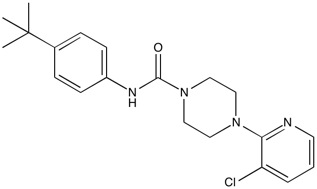BCTC | TRPV1 blocker
NMR (Conforms)

Available Options
| size : | Price | Quantity | |
|---|---|---|---|
| 10 mg | $60.00 | ||
| 50 mg | $255.00 |
BCTC (393514-24-4) is a vanilloid receptor I (TRPV1) blocker, IC50 = 35 nM for capsaicin-induced and 6 nM for acid-induced TRPV1 activation. Displays analgesic activity in rat models of neuropathic pain. BCTC is orally active and cell permeable.
References/Citations:
1) Valenzano et al. (2003), N-(4-tertiarybutylphenyl)-4-(3-chloropyridin-2-yl)tetrahydropyrazine -1(2H)-carbox-amide (BCTC), a novel, orally effective vanilloid receptor 1 antagonist with analgesic properties: I. in vitro characterization and pharmacokinetic properties; J. Pharmacol. Exp. Ther., 306 377
2) Pomonis et al. (2003), N-(4-Tertiarybutylphenyl)-4-(3-cholorphyridin-2-yl)tetrahydropyrazine -1(2H)-carbox-amide (BCTC), a novel, orally effective vanilloid receptor 1 antagonist with analgesic properties: II. in vivo characterization in rat models of inflammatory and neuropathic pain; J. Pharmacol. Exp. Ther., 306 387
NMR (Conforms)
Safety Data Sheet:
Product Data Sheet:
Materials provided by Focus Biomolecules are for laboratory research use only and are not intended for human or veterinary applications. Please note that we do not sell to individuals and that all orders placed by non-research organizations will incur a $20 restocking/refund fee
BCTC (393514-24-4) is a vanilloid receptor I (TRPV1) blocker, IC50 = 35 nM for capsaicin-induced and 6 nM for acid-induced TRPV1 activation. Displays analgesic activity in rat models of neuropathic pain. BCTC is orally active and cell permeable.
References/Citations:
1) Valenzano et al. (2003), N-(4-tertiarybutylphenyl)-4-(3-chloropyridin-2-yl)tetrahydropyrazine -1(2H)-carbox-amide (BCTC), a novel, orally effective vanilloid receptor 1 antagonist with analgesic properties: I. in vitro characterization and pharmacokinetic properties; J. Pharmacol. Exp. Ther., 306 377
2) Pomonis et al. (2003), N-(4-Tertiarybutylphenyl)-4-(3-cholorphyridin-2-yl)tetrahydropyrazine -1(2H)-carbox-amide (BCTC), a novel, orally effective vanilloid receptor 1 antagonist with analgesic properties: II. in vivo characterization in rat models of inflammatory and neuropathic pain; J. Pharmacol. Exp. Ther., 306 387
Calculate the molar concentration, mass or volume in a solution.
Concentration × Volume × Molecular Weight = Mass
Focus Biomolecules • Plymouth Meeting, PA USA • 1-855-FOCUS21
Focus Biomolecules
Plymouth Meeting, PA USA
1-855-FOCUS21
Website Created by Advanta Advertising LLC.

